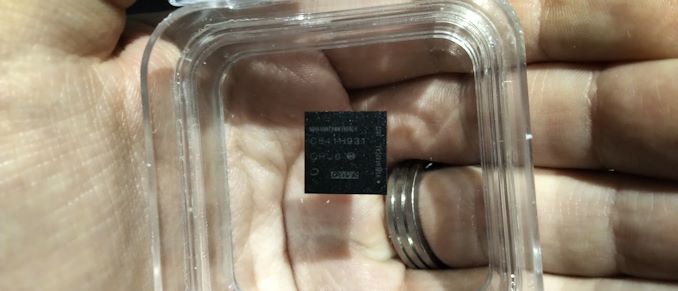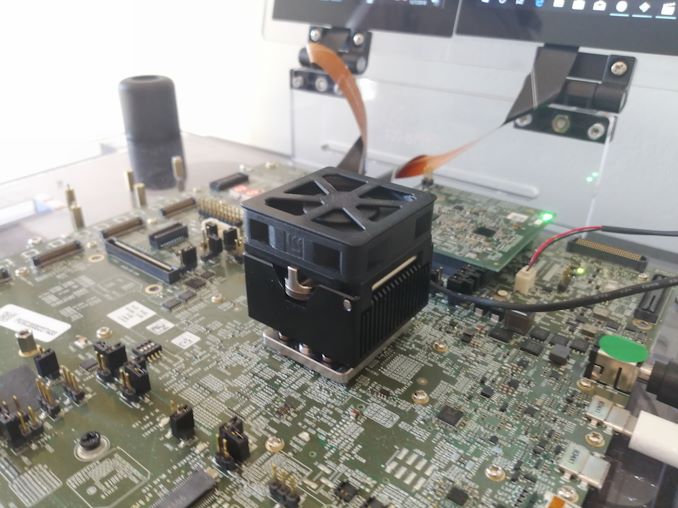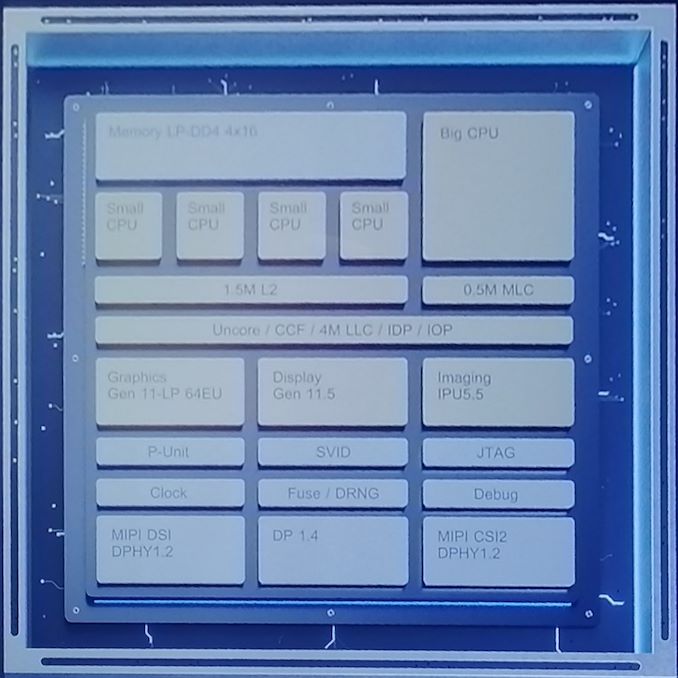Intel's Architecture Day 2018: The Future of Core, Intel GPUs, 10nm, and Hybrid x86
by Dr. Ian Cutress on December 12, 2018 9:00 AM EST- Posted in
- CPUs
- Memory
- Intel
- GPUs
- DRAM
- Architecture
- Microarchitecture
- Xe
Intel’s First Fovoros and First Hybrid x86 CPU: Core plus Atom in 7 W on 10 nm
Perhaps someone will correct me, but I can’t ever remember a time when Intel has put multiple x86 cores of different configurations on the same bit of silicon (ed: Intel Edison). Ever since Arm starting doing it with its big.Little designs in smartphones, a perennial question was if Intel was going to do something similar, either with big and small Atom cores, or by moving a high-performance Core into the mix. When Intel left the smartphone and tablet market, we assumed the idea was dead. But, like a reanimated zombie, it has risen from the grave. Enter Intel’s Hybrid x86 CPU.
This tiny 12x12 package is built using Intel’s Fovoros technology, using a 22FFL IO chip as the active interposer connected with TSVs to a 10nm die that contains both a single Sunny Cove core and four Atom (Tremont?) cores. This tiny chip is smaller than a dime, and is designed to have a 2 mW standby power. It would appear that this chip is destined for mobile devices.
Here’s the manufacturing diagram, showing the idea that POP memory is placed over the Fovoros design to give the final product. Very much like a mobile chip.
The demo system that Intel had on display looked similar to the previous Sunny Cove design, however this heatsink was smaller and it had a few different connectors. We were told that this chip will support PCIe for M.2 as well as UFS, both of which are found in mobile. There also looked like a couple of SIM card connectors on this motherboard.
The key part of this discussion however is this block diagram that was on one of the Intel slides. Here we see a single ‘Big CPU’ with 0.5 MB of private medium level cache, four ‘Small CPU’s with a shared 1.5 MB L2 cache, an uncore that has 4MB of last level cache, a quad-channel memory controller (4x16-bit) with support for LPDDR4, a 64 EU design with Gen11 graphics, the Gen 11.5 display controller, a new IPU, MIPI support with DisplayPort 1.4, and all of this in a tiny package.
Seriously though, this has the potential to be a large revenue stream for Intel. They’ve made this chip, which allows the cores to enter C6 sleep states when not in use, that has a die size smaller than 12x12mm (144 mm2), and target the sub-7W fanless device market. That’s with a big Core, four Atom cores, and a GT2 64 EU design.
Intel actually says that the reason why this product came about is because a customer asked for a product of about this performance but with a 2 mW standby power state. In order to do this, Intel created and enhanced a number of technologies inside the company. The final product is apparently ideal for the customer, however the chip will also be made available for other OEMs.
In our Q&A session with the senior members of Intel, it was clear that this technology is still in its infancy, and Intel now has a new toy to play with. Jim Keller stated that internally they are trying lots of new things with this technology to see what works and what would make a good product, so we should be seeing more Foveros designs through 2019 and 2020.















148 Comments
View All Comments
peevee - Tuesday, December 18, 2018 - link
"Normally cache misses decrease by a factor of a square root of the proportional size when the cache is increased"This is neither true in most performance-critical real cases nor can provide any estimate of actual performance increase.
mikato - Friday, December 21, 2018 - link
I'm here for the "raja inside" comments. Disappointed.peevee - Sunday, December 23, 2018 - link
"although it was pointed out that these improvements won’t help everyone, and might require new algorithms in order to use specific parts of the core."Which means it will help almost no one, as very few will optimize specifically for that core.
"We’re waiting to see what changes Intel has made on the front-end, which is where a lot of low-hanging fruit often lies for performance."
Low-hanging fruit in x86 was picked up in Pentium. Since then it is just more and more kludges which cost more energy than improve performance (normalizing for node).
peevee - Sunday, December 23, 2018 - link
"64 EUs... Each EU will support seven threads as before, which means that the entire GT2 design will essentially have 512 concurrent pipelines."Math?
And are these threads? Or ALUs?
peevee - Sunday, December 23, 2018 - link
"The 7-Zip demo was relatively straight forward, showing how the new instructions such as Vector-AES and SHA-NI in Sunny Cove can give the processor a 75% boost in performance over an equivalent Skylake based platform at iso-frequency."Huh? Have they recompiled (what compiler supports the new instructions then), or manually wrote a codepath in asm? And enabled encryption so to get any increase, so the increase is not actually for compression? Have they disabled compression too? ;)
dampf - Wednesday, January 2, 2019 - link
Really Intel? Adding AI improvements to Core architecture in 2021? Smartphone vendors were doing it last year... way too late. And 5G will take off in the end of 2019.TheJian - Wednesday, January 2, 2019 - link
I guess I'm not getting why I should be impressed by this.https://www.electronicsweekly.com/news/design/comm...
Leti already did it? They say it's IP can be used by others, so is this Intel's solution (what they're using I mean)?
AMD already does chiplets, everyone does socs (Intel failed them)...etc. 144mm^2 not that small (about an large apple soc size). Current 7nm A12 is 83mm^2 with 6.9B transistors and two big cores, 4 small. AMD already did interposer/chiplets. Memory has been stacking for a while now. Not sure what is supposed to impress me here.
"Very much like a mobile chip" ...Pretty much...Again, why so impressed?
And as OP noted, you have no idea how big the market is, nor how much they can make on them. I think they have to try to sell some before we can say that (many Intel things killed over the years), as their last mobile strategy cost them 16B+ in giveaways, and lost the fab race for a while (maybe forever, because that 16B lost should have went DIRECTLY into fabs and 10nm wouldn't be crap now), as once 7nm Intel hits, it looks like TSMC beats them anyway with 5nm (ok, tie? whatever). My point here is Intel's 7nm won't be much ahead of tsmc 5nm if at all as that is what it will compete with since tapeouts happen q2 2019 and chips 12-15 months later.
https://www.extremetech.com/computing/278742-tsmc-...
Many other articles out there like this, but has a good chart of when and how much wafers etc. But if risk production is really as they say, 5nm chips by xmas 2020. That puts Intel where with this @7nm? Unless that answer is XMAS 2020, I'm thinking behind tsmc. It looks like TSMC is aiming before xmas and they've been moving at a good clip without many glitches recently, so Intel better get busy IMHO. TSMC is 2q 2019 risk, or 2H 2019 depending on who you believe I guess. But still, Intel 7nm better hit by xmas 2020 then right?
Comments on last page: Uh, should have bought NV under $10 but couldn't take the best from gpu side because nobody could handle Jen as president :) WOW, look at that value you passed up Intel, oh, and you'd RULE mobile by now with all those tegras being on Intel's process 5+yrs ago (never mind what gpus would have done on Intel during this time) and you already had the modem solution too (NV bought one, and had to kill it, intel would have taken over everything cpu/gpu/modem/mobile).
With chromebooks, 2b mobile units not using NV gpu's etc, nobody would have stopped them at FTC since more gpus, and arguably more computing devices ship without WINTEL, Intel's gpus (even with NV in there) etc. Intel gpus wouldn't have been needed, mobile wouldn't have been lost (14nm Intel NV socs would have competed well against 20nm everyone else, same story before 14/20, Intel 22nm NV socs vs. 28nm everyone else)., fab money wouldn't have been blown on mobile etc etc. All the problem Intel has now are because they blew 16B on failing instead of BUYING NV for that or a bit more. They had a value back then ~6B or less 659mil shares at $10, I bought at 12...ROFL. They should have owned NV anywhere in there and all this crap wouldn't have happened...LOL. We'll see how this "ideas from outside" crap works out now. To be fair AMD had the same problems to some extent, firing Dirk for not liking mobile/tablet/apu, and wanting a KING first then that cheap crap later. Now they chase king cpu (not gpu yet so far) again...LOL. Yeah, I own AMD stock but still think management is dumb. Can't price anything right, always trying to be a friend or get share which means NOTHING if it doesn't come with MARGIN as a poor man. Sure the rich guy can flood a market, kill enemy sales, but only because he has wads of cash and can wait until he breaks you. Poor company needs NET INCOME for the next gen R&D and to retain people like KELLER etc.
I'm only in AMD stock for the 7nm server stuff, then out likely. Rumor/hype work well in advance of real product at amd (talking stock price here), so you don't likely have to wait for anything other then "shipping soon" or some leaked benchmarks etc. and the price will head to 40+ probably. Just run before that reality hits or brave the waves...LOL. I think AMD will make money, certainly has the server chips to do it, but management just seems to fail at pricing anything to take advantage while they can. Too worried about market, instead of MARGIN for R&D. I'd rather own the 10% that makes most of the money than the 80% that makes crap+a little midrange crap. Apple thinks the same, see their Q reports for ages etc. Own the rich so you can afford to supply the poor. It doesn't work the other way around generally speaking, especially as the little guy. You can't bleed as the poor little guy ;)
TheJian - Wednesday, January 2, 2019 - link
One more point, in case anyone brings it up, A12x 122mm^2 10B transistors. just adds two more big cores IIRC (maybe a few other small changes). Same point though.